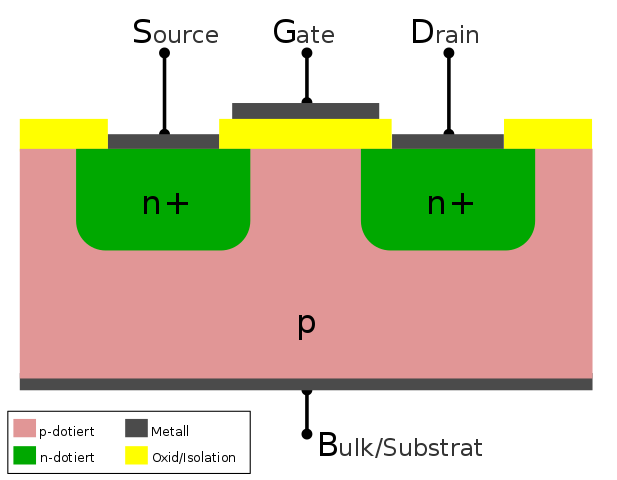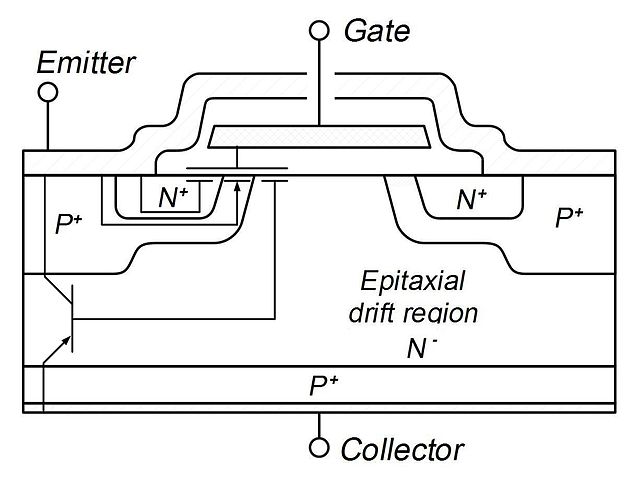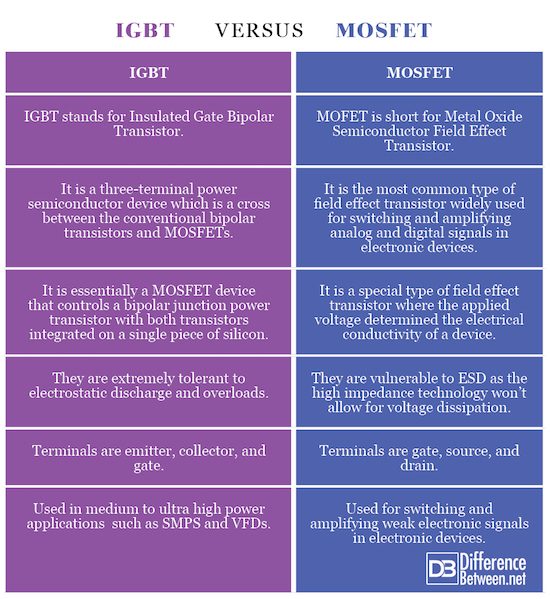Difference Between IGBT and MOSFET
The bipolar transistors were the only real power transistor used until the very efficient MOSFETs came along in the early 1970’s. The BJTs have gone through vital enhancements of its electrical performance since its inception in late 1947 and is still widely used in electronic circuits. The bipolar transistors have relatively slow turn-off characteristics and they exhibit negative temperature coefficient which may result in secondary breakdown. MOSFETs, however, are devices that are voltage controlled rather than current-controlled. They have positive temperature coefficient for resistance that stops thermal runaway and as a result secondary breakdown does not occur. Then, IGBTs came into the picture in the late 1980s. The IGBT is basically a cross between the bipolar transistors and MOSFETs and is also voltage-controlled like MOSFETs. This article highlights some key points comparing the two devices.
What is a MOSFET?
MOSFET, short for “Metal Oxide Semiconductor Field Effect Transistor”, is a special type of field effect transistor widely used in very large scale integrated circuits, thanks to its sophisticated structure and high input impedance. It’s a four-terminal semiconductor device that controls both analog and digital signals. The gate is located between the source and drain and is insulated by a thin layer of metal oxide which prevents the current from flowing between the gate and the channel. The technology is now used in all kinds of semiconductor devices to amplify weak signals.
What is an IGBT?
IGBT, stands for “Insulated Gate Bipolar Transistor”, is a three-terminal semiconductor device which combines the current-carrying capability of a bipolar transistor with the ease of control of that of a MOSFET. They are a relatively new device in power electronics typically used as an electronic switch in a wide a range of applications, from medium to ultra high power applications such as switched mode power supplies (SMPS). Its structure is almost identical to that of a MOSFET except the additional of a p substrate beneath the n substrate.
Difference between IGBT and MOSFET
-
Basic of IGBT and MOSFET
IGBT stands for Insulated-Gate Bipolar Transistor, whereas MOSFET is short for Metal-Oxide Semiconductor Field Effect Transistor. Although, both are voltage-controlled semiconductor devices that work best in switch mode power supply (SMPS) applications, IGBTs combine the high-current handling capability of bipolar transistors with the ease of control of MOSFETs. IGBTs are gatekeepers of current that combine the advantages of a BJT and MOSFET for use in power supply and motor control circuits. MOSFET is a special type of field-effect transistor in which the applied voltage determines the conductivity of a device.
-
Working Principle of IGBT and MOSFET
An IGBT is essentially a MOSFET device that controls a bipolar junction power transistor with both transistors integrated on a single piece of silicon, whereas MOSFET is the most common insulated gate FET, most commonly fabricated by the controlled oxidation of silicon. MOSFET generally works by electronically varying the width of the channel by the voltage on an electrode called the gate which is located between the source and the drain, and is insulated by a thin layer of silicon oxide. A MOSFET can function in two ways: Depletion mode and Enhancement mode.
-
Input Impedance of IGBT and MOSFET
An IGBT is a voltage-controlled bipolar device with high input impedance and large current-handling capability of a bipolar transistor. They can be easy to control as compared to current controlled devices in high current applications. MOSFETs require almost no input current to control the load current which makes them more resistive at the gate terminal, thanks to the isolation layer between the gate and the channel. The layer is made of silicon oxide which is one of the best insulators used. It efficiently blocks the applied voltage with the exception of a small leakage current.
-
Damage Resistance
MOSFETs are more susceptible to electrostatic discharge (ESD) as high input impedance of MOS technology in a MOSFET won’t allow the charge to dissipate in a more controlled fashion. The additional silicon oxide insulator reduces the capacitance of the gate which makes it vulnerable against the very high voltage spikes inevitably damaging the internal components. MOSFETs are very sensitive to ESDs. The third generation IGBTs combines the voltage drive characteristics of a MOSFET with the low on-resistance capability of a bipolar transistor, thus making them extremely tolerant against overloads and voltage spikes.
-
Applications of IGBT and MOSFET
MOSFET devices are widely used for switching and amplifying electronic signals in electronic devices, typically for high noise applications. The most application of a MOSFET is in switch mode power supplies, plus they can be used in class D amplifiers. They are the most common field effect transistor and can be used in both analog and digital circuits. IGBTs, on the other hand, are used in medium to ultra high-power applications like switch mode power supply, induction heating, and traction motor control. It is used as a vital component in modern appliances such as electric cars, lamp ballasts, and VFDs (variable frequency drives).
IGBT vs. MOSFET: Comparison Chart
Summary of IGBT Vs. MOSFET
Although both IGBT and MOSFET are voltage-controlled semiconductor devices mainly used to amplify weak signals, IGBTs combine the low on-resistance capability of a bipolar transistor with the voltage drive characteristics of a MOSFET. With the proliferation of choices between the two devices, it’s becoming increasingly difficult to choose the best device based on their applications alone. MOSFET is a four-terminal semiconductor device, whereas IGBT is a three-terminal device which is a cross between the bipolar transistor and a MOSFET which makes them extremely tolerant to electrostatic discharge and overloads.
- Difference Between Caucus and Primary - June 18, 2024
- Difference Between PPO and POS - May 30, 2024
- Difference Between RFID and NFC - May 28, 2024
Search DifferenceBetween.net :
Leave a Response
References :
[0]Image credit: https://upload.wikimedia.org/wikipedia/commons/thumb/6/6c/IGBT_Cross_Section.jpg/637px-IGBT_Cross_Section.jpg
[1]Image credit: https://upload.wikimedia.org/wikipedia/commons/thumb/3/34/Scheme_of_metal_oxide_semiconductor_field-effect_transistor.svg/617px-Scheme_of_metal_oxide_semiconductor_field-effect_transistor.svg.png
[2]Valizadeh, Pouya. Field Effect Transistors: A Comprehensive Overview. New Jersey: John Wiley & Sons, 2016. Print
[3]Baliga, Jayant B. Fundamentals of Power Semiconductor Devices. Berlin: Springer, 2010. Print
[4]Gowar, John. Power MOSFETs: Theory and Applications. New Jersey: John Wiley & Sons, 1989. Print



